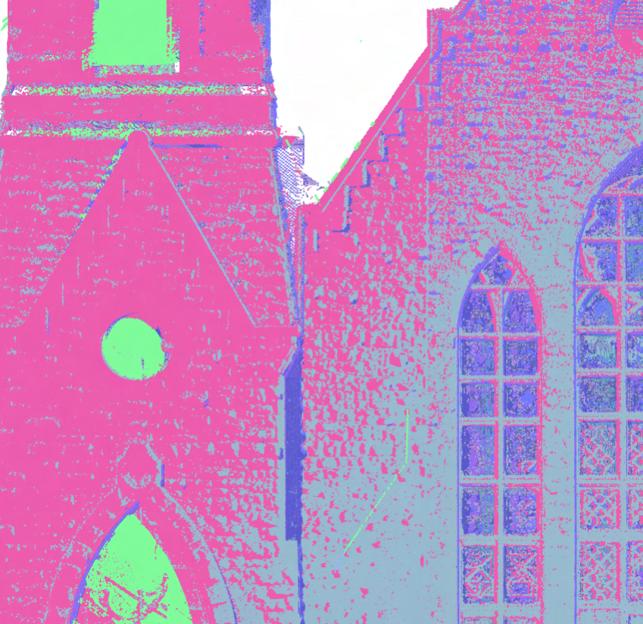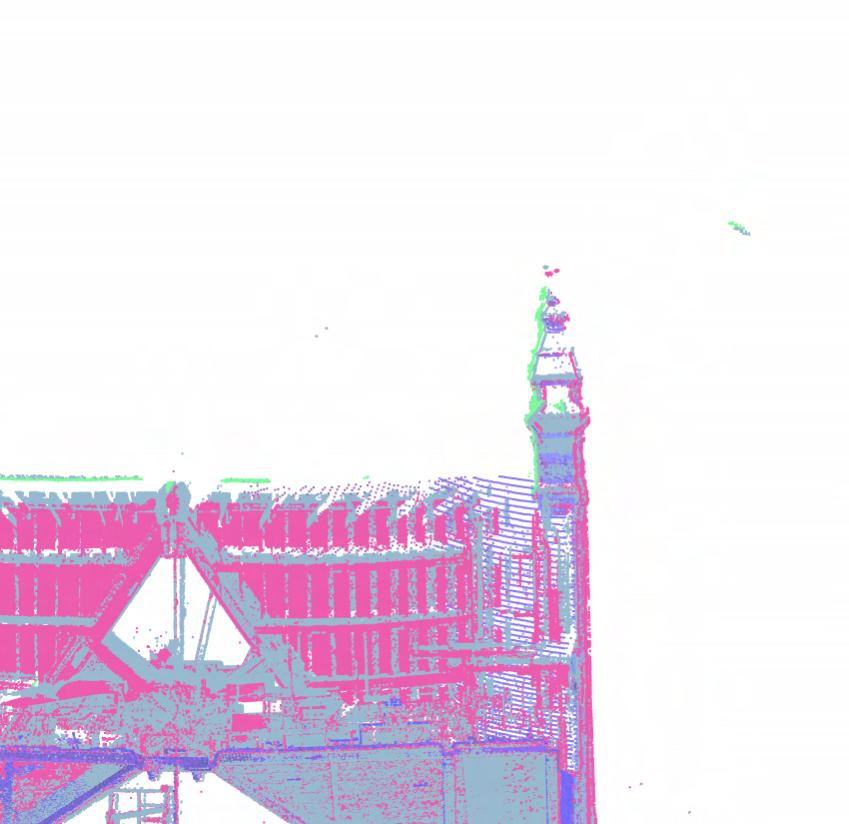














BRADEN COOPER


















bpcooper.myportfolio.com
PROFESSIONAL
Project
Project 3: Castello Svevi Di Trani................................17
Project
Project
ACADEMIC

















BRADEN COOPER


















bpcooper.myportfolio.com
PROFESSIONAL
Project
Project 3: Castello Svevi Di Trani................................17
Project
Project
ACADEMIC

• Rome, Italy
• Partners: Simone Capra, Dario Scaravelli, and Claudio Castaldo
• Role: Architectural Designer
“The city is made up of a sequence of spaces, open and closed, architectures and urban complexes, of small and large dimensions, in which people, environments, cultures and economies live and interact. In this complex terrain, STARTT drives the design of architectural and urban projects, combining the vision on the city and its buildings with the reflection on the sustainability, the social dynamics and the culture of a territory.”
Over my 10 month stretch working at STARTT, I had the opportunity to collaborate with Fabio Coletta, Claudia Zuccarello, Sansone Segre, Cecilia Rosa, Margherita Pane, Antonio De Paulo, Pietro Bartuli, and Jacob Gasper. My experience in Rome would not have been the same without each these great young designers.
As a design team member, I was involved in schematic design phases of competition submissions, master planning efforts for historic adaptive re-use projects, and some construction administration work on historic projects. My roles throughout each project were mainly centered around 3D modeling, drawing, and design coordination between external contractors and internal design collaborators.
Project Locations: 1 Rome, 2 Rome, 3 Trani, 4 Boario, 5 Taranto, 6 Lecce 1 2 4 3 5 6





Pantheon
In an effort to open up space for a paid exhibit in the Basilica of Neptune, a change in entry circulation was proposed. This reversal helped improve wheelchair access to the main rotunda and provided convenient access of existing paywall locations that could be used for an additional exhibit in the newly excavated rear (South) area of the temple.


Greek Exhibit
This exhibit will house artifacts found in and around the Pantheon site by Italian archeologists. These artifacts have not been formally viewable inside the Pantheon since 608 CE when the structure was converted to a Christian Church. Putting such artifacts on display will help tell the full story of the Pantheon’s multi-religious existence.


Proposed Museum Entry Point
By reversing the circulation of the main rotunda and occulus space, we are more easily able to direct visitor traffic to a newly proposed Southwest entrance.


This prayer space is located directly adjacent to the proposed entry of the new museum space.

While kept to an extreme minimum, there were a few instances in which our proposed elements required direct connections to the Pantheon’s original masonry.

Pantheon Museography and Typology Exhibit
Using steel framed partition walls we hide exposed electrical and plumbing fixtures behind an exhibit exposing the reinterpretations of the Pantheon throughout the world.

Presentation Space • Director’s Office
Various programmatic requirements were addressed including a director’s office which could easily adapt into a presentation/archival space.


Site and Design Criteria
This 2 month design competition aimed to address the growing needs of the MAXXI museum. The director’s intent was to add an innovative restoration facility closely linked to the main museum.





Both the massing and circulation of our proposal focused on pulling green, inhabitable space, up from the courtyard, onto the roof.





We proposed placing solar panels on the roof garden and pergolas most exposed to southern daylighting, optimizing solar energy gain throughout the year. By carefully positioning the solar panels, we were able to harness sunlight effectively and minimize reliance on non-renewable energy sources.

By extending the building’s circulation up from the surrounding site, through an interior courtyard, and up onto the roof, we returned public space back to the neighborhood.





Using Grasshopper as a means to control the transparency of various focus points on the facade, we attempted to reveal a hidden courtyard.

The perforated metal facade acts as a veil, offering a glimpse of the building’s internal activity while shielding it’s archival and research areas from unwanted sunlight and viewers. It responds to its context by contrasting MAXXI’s texture and reinterpreting her form.









Trani, Italy, boasts a history dating back to ancient times, with influences from the Messapians and Romans. During the Middle Ages, it thrived as a maritime and trading center under Byzantine and Norman rule, leaving a legacy of well-preserved medieval architecture, exemplified by the impressive Trani Cathedral built in 1099.



Combining solutions for universal accessibility and exhibit design in the


• Des Moines Studio
• Partners: Terry Gebard, Rick Sealy, Kristin Lewis, Danielle Herman, and Joe Feldman
• Role: LiDAR Technician Manager and Designer

OPN Architects is a leading design firm renowned for its innovative and sustainable approach to architecture. The firm’s core philosophy revolves around seamlessly blending creativity with functionality, evident in its diverse portfolio that spans commercial spaces, educational institutions, and cultural establishments. What distinguishes OPN is its holistic commitment to design, considering not only the visual appeal but also the environmental impact and user experience, making sustainability a key focus in every project.
With a strong emphasis on eco- conscious architecture, OPN Architects consistently incorporates energy- efficient solutions and environmentally friendly materials. This dedication aligns with contemporary concerns about climate change, reflecting the firm’s proactive role in addressing environmental challenges. Beyond its commitment to sustainability, OPN’s
designs have a transformative impact on communities, shaping educational spaces that inspire learning and cultural structures that become integral landmarks, contributing positively to the social and cultural fabric of the areas it engages with.
With a strong emphasis on eco- conscious architecture, OPN Architects consistently incorporates energy- efficient solutions and environmentally friendly materials. This dedication aligns with contemporary concerns about climate change, reflecting the firm’s proactive role in addressing environmental challenges. Beyond its commitment to sustainability, OPN’s designs have a transformative impact on communities, shaping educational spaces that inspire learning and cultural structures that become integral landmarks, contributing positively to the social and cultural fabric of the areas it engages with.


OPN Architects is a leading design firm renowned for its innovative and sustainable approach to architecture. The firm’s core philosophy revolves around seamlessly blending creativity with functionality, evident in its diverse portfolio that spans commercial spaces, educational institutions, and cultural establishments. What distinguishes OPN is its holistic commitment to design, considering not only the visual appeal but also the environmental impact and user experience, making sustainability a key focus in every project.
With a strong emphasis on eco- conscious architecture, OPN Architects consistently incorporates energy- efficient solutions and environmentally friendly materials. This dedication aligns with contemporary concerns about climate change, reflecting the firm’s proactive role in addressing environmental challenges. Beyond its commitment to sustainability, OPN’s
designs have a transformative impact on communities, shaping educational spaces that inspire learning and cultural structures that become integral landmarks, contributing positively to the social and cultural fabric of the areas it engages with.
With a strong emphasis on eco- conscious architecture, OPN Architects consistently incorporates energy- efficient solutions and environmentally friendly materials. This dedication aligns with contemporary concerns about climate change, reflecting the firm’s proactive role in addressing environmental challenges. Beyond its commitment to sustainability, OPN’s designs have a transformative impact on communities, shaping educational spaces that inspire learning and cultural structures that become integral landmarks, contributing positively to the social and cultural fabric of the areas it engages with.

The restoration of the historic Meyers Barns has the attention and support of many people in the Lisbon area. It is incredibly unique to have a historic piece of Iowa’s farm heritage located so close to the heart of a city. Although they have suffered considerable damage, restoring these once state-of-the-art dairy barns opens countless opportunities for Lisbon that would make this project both a worthy investment for the future and a memorial to the past.
This preservation study was completed by OPN Architects, three years following initial studies by various entities, and will attempt to summarize the project and provide new information informed by new technologies. Following initial studies, the barns were further damaged by a storm in March of 2023 and water has continued to erode the buildings’ foundations which have poor drainage. Each barn will need new roofing and siding, and although it may appear at first glance that much of each barn is damaged, approximately 75% of each original structure has maintained substantial integrity from more than 150 years ago.
We have divided this report into three separate categories: history; preservation and stabilization; and vision for future use. We used Lidar to three-dimensionally scan the buildings and determine major deficiencies. This allows us to slice the buildings like a loaf of bread to understand the structural elements and relationships we cannot always see through visual inspection. The buildings were tagged with plastic ribbons that represent levels of a framing member conditions. While the Lidar scanning can show the relationship in space of a member, it can’t tell the difference between solid or rotted wood member as well as an in-person inspection.






















































The Polk County Life Services Center (PCLSC) opened on November 18, 2024, at 1914 Carpenter Ave. in Des Moines, marking a major step in addressing homelessness, addiction, and mental health crises. The center serves as a central hub for essential services, aiming to reduce strain on emergency rooms and law enforcement while promoting long-term stability for vulnerable individuals.
A collaborative effort between Polk County, the City of Des Moines, Broadlawns Medical Center, and St. Vincent de Paul, the facility offers comprehensive crisis intervention and behavioral health services. The 24/7 Sobering Center, run by St. Vincent de Paul, provides a safe alternative to jail or the ER for individuals under the influence. Broadlawns Medical Center staffs a Crisis Observation Center and Behavioral Health Urgent Care unit, ensuring immediate psychiatric care and support for those in crisis.
The project was funded through local efforts and a $750,000 federal grant secured by Congressman Zach Nunn. The center connects individuals to housing assistance, job placement, and case management, aiming to break cycles of crisis and instability.
Since opening, the center has seen high demand, with the Sobering Center especially busy. Early reports show it’s easing pressure on hospitals and law enforcement, offering a structured alternative for individuals in crisis. While some local residents worry about crime and loitering, officials have engaged in public outreach to address concerns, emphasizing the center’s role in enhancing community safety.
The Polk County Life Services Center is a significant step forward in tackling systemic social challenges in Des Moines. By providing immediate intervention and long-term support, it serves as a model for balancing public health, safety, and compassionate care.







3D Printed Detail Mock Up
In an effort to gain control of specified products that would ultimately be used in construction, we mocked up various connection hardwear options to identify which combination best suited our design intent.


Rhino Inside Revit • Multi Material Custom Family Scirpt Using Grasshopper to suppliment Revit families allowed us to iterate more freely throughout the interior design process, especially when it came to soft edges related to trauma informed design.


Rhino Inside Revit • Multi Material Custom Family Scirpt
Using Grasshopper to suppliment Revit families allowed us to iterate more freely throughout the interior design process, especially when it came to soft edges related to trauma informed design.
• Arch 301
• Fall 2018
• Professor Ayodele Iyanalu
• Project by Mat Townsley and Braden Cooper
• Hansen Prize Finalists
Discreet Land-Shapes: “The overall theme of this studio stems from the general concept of discreet structures. A discreet structure should be designed carefully with spatial actions that avoid causing offense when possible. We will explore this capacity of minerals to influence architectural culture and land-shapes, through their ability to naturally shape our landscapes and ultimately enhance our quality of life. Through research, abstract explorations and drawings to comprehensive structures and land-shapes. Every landscape has a mineral story to tell. One that dates back to its initial formative state or artificial man-made stage.”
Using this brief, we have incorporated the elements obsidian and smithsonite throughout our design process. We have taken the stance that to truly inhabit a landscape, architecture must take ownership of what is necessary and be respectfully discreet otherwise. We do this by using form and positioning to proclaim the buildings presence while finding “discreetness” in using a lightweight ETFE structural system that allows plentiful light to illuminate the buildings interior for its educational functions.





1 K 1/4 K

Site visits and soil hydrology research helped influence the placement of our proposal in relation to its surroundings


The ETFE facade helps blend the lighting and appearance of its surroundings on both the exterior an interior
By using precedents such as Grimshaw’s Eden Project, we developed ETFE construction details that would meld with our CLT framed superstructure.

At 1’=1” scale, we made use of overlapping techniques used in CLT and mass timber structures to address each members in detail. We laser cut each individual piece to interlock with its counterparts.

Using the volcanic mineral of obsidian as precedent, we mimicked the rippled distribution of layers in our structural system.

Each pillow was made by sculpting a clay mold by hand, then vacuum forming acrylic sheets that took its form. They were then adhered to the steel space frame accordingly.

Although the final model was not the focus of our presentation, it served as a useful investigation tool in our effort to rationalize the project.

We used large hand drawings as a design tool throughout the entire studio project. Using elements from our physical model, we traced section profiles onto ling sheets of paper and began illustrating the proportions and spatial relationships of Inflosion.

This hand drawn elevation served as one of our main iterative outlets throughout the timeline of this studio. Each iteration of the drawing was 6’ x 2’ and took about 3 hours to complete.


